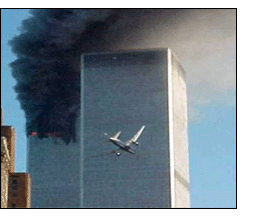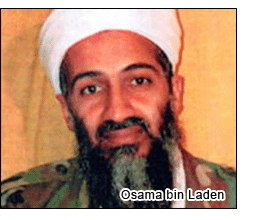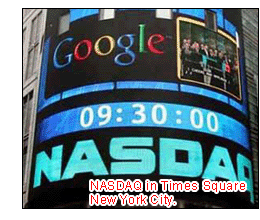Warm up
Questions
- What happened in the United States of America on September 11, 2001?
- What impacts did the terror attacks produce on different industries of the United States?
- What did the U.S. government and different industries do to counteract the impacts?
Background
September 11 attacks
 The explosion resulting from the crashing of United Airlines Flight 175 into the South Tower. A huge plume of smoke and fire can be seen emerging from the North Tower to the left.
The explosion resulting from the crashing of United Airlines Flight 175 into the South Tower. A huge plume of smoke and fire can be seen emerging from the North Tower to the left.
The most destructive attack of terrorism ever launched against the United States. The attacks were planned well in advance; the militants-most of whom were from Saudi Arabia and were widely believed to be part of the Al Qaeda network -traveled to the U.S. beforehand, where a number received commercial flight training. Working in small groups, the hijackers boarded 4 domestic airliners in groups of 5 (a 20th participant was alleged) on Sept. 11, 2001, and took control of the planes soon after takeoff. At 8:46 AM (local time), the terrorists piloted the first plane into the north tower of the World Trade Center in New York City. A second plane struck the south tower some 15 minutes later. Both structures erupted in flames and, badly damaged, soon collapsed. A third plane struck the southwest side of the Pentagon near Washington, D.C., at 9:40, and within the next hour the fourth crashed in Pennsylvania after its passengers-aware of events via cellular telephone-attempted to overpower their assailants. Some 2,750 people were killed in New York, 184 at the Pentagon, and 40 in Pennsylvania. All 19 terrorists died.
The attacks provoked outrage not only in the United States, but also abroad, both because of their savagery and because roughly ten percent of those killed in the collapse of the twin towers were foreign nationals.
In addition to the human carnage, the attacks severely crippled both the U.S. and foreign economies. For example, in the wake of the attacks, air travel plummeted and insurance companies faced enormous costs for the damage. Many Americans compared the attacks to Pearl Harbor, because they took an unprepared America by surprise.
Osama bin Laden
 Osama bin Laden, born on March 10, 1957, in Riyadh of Saud. Arabia, is leader of a broad-based Islamic extremist movement implicated in numerous acts of terrorism against the U.S. and other Western countries. The son of a wealthy Saudi family, he joined the Muslim resistance in Afghanistan after the 1979 Soviet invasion of that country. Following his homecoming, he became enraged at the presence of U.S. troops in Saudi Arabia during the Persian Gulf War (1990 – 91) and, through a network of like-minded Islamic militants known as al-Qaeda, launched a series of terrorist attacks. These acts included the bombings of the World Trade Center in New York City in 1993, the U.S. embassies in Kenya and Tanzania in 1998, and the U.S. warship Cole in Aden, Yemen, in 2000. A self-styled Islamic scholar, bin Laden issued several legal opinions calling on Muslims to take up jihad (holy war) against the U.S., and in 2001 a group of militants under his direction launched the September 11 attacks, which led to the deaths of some 3,000 people. The U.S. thereafter demanded bin Laden's extradition from Afghanistan, where he was sheltered by that country's Taliban militia, and launched attacks on Taliban and al-Qaeda forces when that ultimatum was not met. With the collapse of the Taliban, bin Laden and his associates went into hiding.
Osama bin Laden, born on March 10, 1957, in Riyadh of Saud. Arabia, is leader of a broad-based Islamic extremist movement implicated in numerous acts of terrorism against the U.S. and other Western countries. The son of a wealthy Saudi family, he joined the Muslim resistance in Afghanistan after the 1979 Soviet invasion of that country. Following his homecoming, he became enraged at the presence of U.S. troops in Saudi Arabia during the Persian Gulf War (1990 – 91) and, through a network of like-minded Islamic militants known as al-Qaeda, launched a series of terrorist attacks. These acts included the bombings of the World Trade Center in New York City in 1993, the U.S. embassies in Kenya and Tanzania in 1998, and the U.S. warship Cole in Aden, Yemen, in 2000. A self-styled Islamic scholar, bin Laden issued several legal opinions calling on Muslims to take up jihad (holy war) against the U.S., and in 2001 a group of militants under his direction launched the September 11 attacks, which led to the deaths of some 3,000 people. The U.S. thereafter demanded bin Laden's extradition from Afghanistan, where he was sheltered by that country's Taliban militia, and launched attacks on Taliban and al-Qaeda forces when that ultimatum was not met. With the collapse of the Taliban, bin Laden and his associates went into hiding.
Very important terms
dot-com 商业域名
Colloquial name given to start-up companies that sell goods and services over the Internet. Dot-coms proliferated in the 1990s, but many failed by early 2000. The name comes from the “.com” ending of the Internet address of such companies.
The Federal Reserve System 联邦储备系统
Known as the Fed, the Federal Reserve System sets the discount interest rate, the base rate at which its member banks may borrow, and oversees a network of 12 Federal Reserve Banks located in major US cities; these in turn regulate banks in their districts and ensure they maintain adequate reserves. The Fed also clears money transfers, issues currency, and buys or sells government securities to regulate the money supply. Through its powerful New York bank, the Fed conducts foreign currency transactions, trades on the world market to support the US dollar's value, and stores gold for foreign governments and international agencies.
Dow Jones Industrial Average - DJIA 道琼斯工业平均指数
The Dow Jones Industrial Average, invented by Wall Street Journal editor and Dow Jones & Company founder Charles Dow back in 1896, is a price-weighted average of 30 leading industrial stocks traded on the New York Stock Exchange, compiled by Dow Jones & Co., and published daily in the Wall Street Journal. The industrial average is one of four securities averages computed by Dow Jones; the others are a 20-stock transportation average, an average of 15 utility stocks, and a composite averaging all of these securities. The industrial average is the most popular, and is widely quoted as an indicator of stock prices and investor confidence in the securities market.
Often referred to as "the Dow", the DJIA is the oldest and single most watched index in the world. The DJIA includes companies like AlliedSignal, Aluminum Company of American (Alcoa), American Express, AT&T, Boeing, Caterpillar, Chevron, Citigroup, Coca-Cola, Disney, DuPont, Eastman Kodak, Exxon, General Electric, General Motors, Goodyear, Hewlett-Packard, IBM, International Paper, Johnson & Johnson, McDonald's, Merck, Minnesota Mining & Manufacturing (3M), Morgan (J.P.), Philip Morris, Procter & Gamble, Sears, Travelers', Union Carbide, United Technologies, and Wal-Mart Stores.
When the TV networks say "the market is up today", they are generally referring to the Dow. Changes in the average (noted as “rises” and “falls”) give investors a general picture of the state of the market.
Nasdaq 全国证券交易商自动报价系统(纳斯达克)
 Established in 1971 by the National Association of Securities Dealers (NASD), NASDAQ, the world's first electronic stock market, is a computerized quotation system that facilitates trading and provides price quotations on some 5,000 of the more actively traded over-the-counter stocks (which are not listed on the regular stock exchanges). It publishes two composite price indexes daily as well as bank, insurance, transportation, utilities, and industrial indexes in the financial pages of most newspapers. By the 1990s it had surpassed the American Stock Exchange (AMEX) in annual share volume, mainly because of its popularity with investors of emerging high-tech companies, and had become the second largest U.S. securities market, in terms of market capitalization, after the New York Stock Exchange. In 1999 it merged with AMEX to form the Nasdaq-Amex Market Group, and in 2000 NASD sold nearly half its interest in NASDAQ to private investors.
Established in 1971 by the National Association of Securities Dealers (NASD), NASDAQ, the world's first electronic stock market, is a computerized quotation system that facilitates trading and provides price quotations on some 5,000 of the more actively traded over-the-counter stocks (which are not listed on the regular stock exchanges). It publishes two composite price indexes daily as well as bank, insurance, transportation, utilities, and industrial indexes in the financial pages of most newspapers. By the 1990s it had surpassed the American Stock Exchange (AMEX) in annual share volume, mainly because of its popularity with investors of emerging high-tech companies, and had become the second largest U.S. securities market, in terms of market capitalization, after the New York Stock Exchange. In 1999 it merged with AMEX to form the Nasdaq-Amex Market Group, and in 2000 NASD sold nearly half its interest in NASDAQ to private investors.
NASDAQ is the largest electronic screen-based equity securities market in the United States. With approximately 3,200 companies including Microsoft, Intel, Dell and Cisco, it lists more companies and, on average, trades more shares per day than any other U.S. market. The current chief executive officer is Robert Greifeld.
On July 17, 1995, the NASDAQ Composite index closed above the 1,000 mark for the first time. The index peaked at an intra-day high of 5,132.52 on March 10, 2000, which signaled the beginning of the end of the dot-com stock market bubble. The index declined to half its value within a year, and finally found a bear market bottom at its intra-day low of 1,108.49 on October 10, 2002. While the index has gradually recovered since then, reaching a six-year monthly closing high above the 2,400 level on November 30, 2006, it is still (as of late 2006) valued at less than half its peak.
The term "Nasdaq" used to be capitalized "NASDAQ" as an acronym for National Association of Securities Dealers Automated Quotation. In recent times, the acronym was dropped, and Nasdaq is now used as a proper noun.

